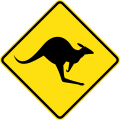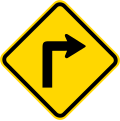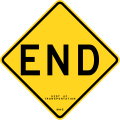-
An empty cart
You have no item in your shopping cart
Modern traffic warning sign shapes and colors
A Safety warning sign is a type of sign which indicates a potential hazard, obstacle or condition requiring special attention.These signs are often temporary in nature and used to indicate road work (construction), poor roads, or temporary conditions ahead on the road including: flagmen, survey crew, single-lane, detour, bridge out, utility crew ahead, blasting area, bump, dip, frost heaves, flooding (with signs labeled “High water”), soft shoulder, uneven pavement, freshly oiled road, loose gravel, smoke on road, trucks entering, etc. (Note that some “high water” signs are posted to alert drivers of a flood-prone area and do not actually mean that there is a flooded section of road ahead.) In France, Italy, Spain, Norway etc., warning (and speed limit) signs connected with road work have a yellow background in place of the usual white background on signs. In America and Ireland, signs connected with road work have an orange background
General caution
General safety warning signs are used in instances in which the particular hazard, obstacle or condition is not covered by a standard sign. In Europe, they usually comprise on the standard triangular sign ( ⚠) with an auxiliary sign below in the local language identifying the hazard, obstacle or condition. In countries using diamond-shaped signs, the explanatory language is often written directly on the diamond-shaped sign, although it may contain only a general warning such as “Caution”, and pictograms may also be used.
Obstacles
Warning signs can be placed in advance of, next to or on a specific obstacle. Obstacles such as railway level crossings may have several warning signs beforehand, while bridge ramparts typically have reflective signs placed directly on them on either side. These signs can be specific to the shape requirements of the obstacle, for example, bridge rampart signs are often tall and skinny so as not to intrude into the lane.
Animals crossing the roadway
These signs warn of wild animals (moose, bear, elk, deer, reindeer, polar bears, camels, wallabies, kangaroos, alligators, etc.) or farm animals (cows, horses, ducks, sheep) that may stray onto the road. In the United States, a “share the road” plaque is sometimes placed below these warning signs when used in this manner.
Unusual vehicles in roadway
Thesesafety warning signs are found where road users could encounter slow, large or non-typical vehicle such as tractors, forklifts, snowmobiles, Amish buggies etc. They are more common around quarries, airports, industrial zones and rural areas.
Road work or construction
These signs are often temporary in nature and used to indicate road work (construction), poor roads, or temporary conditions ahead on the road including: flagmen, survey crew, single-lane, detour, bridge out, utility crew ahead, blasting area, bump, dip, frost heaves, flooding (with signs labeled “High water”), soft shoulder, uneven pavement, freshly oiled road, loose gravel, smoke on road, trucks entering, etc. (Note that some “high water” signs are posted to alert drivers of a flood-prone area and do not actually mean that there is a flooded section of road ahead.) In France, Italy, Spain, Norway etc., warning (and speed limit) signs connected with road work have a yellow background in place of the usual white background on signs. In America and Ireland, signs connected with road work have an orange background.
Curves and corners
These signs indicate that dangerous or unexpected bends in the road are ahead. Signs typically indicate whether the curves are to the right or to the left, the angle of the curve and whether it is one curve or a series of curves.
Chevrons and arrows
Arrows on rectangular signs may be placed at the actual location of the bend or curve to further mark the location of the curve and to assist in the negotiation of the curve. They may also be used to indicate “merge” with other traffic, as for an on-ramp of a limited-access highway.
Tunnels
These hazardous warning signs are used to indicate tunnels, where lights are usually required, and a general change in the light level. May also indicate low ceiling clearance. Truck drivers should also watch for prohibited cargo signs (e.g., hamzat, propane, explosives) upon approach to tunnels.
Bridges
These safety warning signs are used where traffic may be constricted to a narrow bridge, or where the bridge may have a movable span closed to vehicles while boats pass. They may also be used for underpass to indicate low overhead clearance.
Traffic signals
These safety warning signs indicate that traffic lights are ahead, and are often used when it is difficult to see that a traffic light may already be showing red, to warn a driver to prepare to slow down. They may be supplemented with flashing light or lighted sign when light is red or turning red.
Warning signs for regulatory signs
As for traffic signals, above, some “stop” or “yield” sign may require additional warning or reminder, especially in dense areas or where the sign has been added recently.
Intersections
These warning safety signs warn of road crossings at forks (Y-intersection). They may also indicate “hidden driveway” intersecting the road ahead. (Compare with bridges,).
Lane starts and ends
These signs indicate when a multilane highway is being narrowed, when a passing lane is ending, or where the road is widening or a passing lane starting. Another type of sign is used to indicate central “two-way” left turning lane in center of roadway. Warning signs may also warn of “Highway ends”, where the road changes class or type.
Merge to stay with through traffic
In the United State and Canada, there is special signage for lanes that are about to exit, so that drivers who wish to remain on the main road have adequate time to merge. Such lanes are sometimes indicated by special striping (“alligator stripes”) and the sign, “Through Traffic Merge Left” (or right). On freeways, the green directions sign for the exit ramp may have the additional notation, “Exit Only,” and should have black letters on a yellow background for emphasis.
Roads with one entry point
Roadways that only have one entry/exit point “not a through street” or “no outlet”.
End of roadway
Signs indicating the end point of a roadway.
Pedestrian crossings
These signs are used to warn drivers of people walking in the street. They may also be used to warn of children playing, playgrounds, bicycle area, deaf child, blind pedestrians, and thickly settled zones where pedestrians may enter the road.
Schools
These signs mark school zones (in which lower speed limits may be in place), student crossings, crossing guards or signals ahead. In the U.S. and Canada, pentagon-shaped signs are used in place of the usual diamond-shaped signs.
Bicycle
Bicycle crossing signs warn that bicycles will cross at their location.
Fire stations
These signs warn of approach to where firefithers may be entering the road with fire engine or other emergency apparatus, where other drivers will have to stop and wait until they pass.
Oncoming traffic
These signs may be used to warn people of oncoming traffic; shown when a moterway becomes a dual carriageway or a normal road without a or median.
Level crossing (railway crossing)
These signs are used to warn of level crossing ahead. In most countries, a red triangle warning sign is used, with various pictograms for unguarded crossings, crossings with manual gates, and automatic level crossings. In most of Europe, an old-style gate is used for a crossing with gates
Falling rocks
These warning safety signs may be used to indicate the hazards of fallen or falling rocks on the road ahead. They are usually pictographs, but may also include wording, such as “fallen rock”, “falling rock”, or “rock slide”.
For example, a warning sign with the image of an aircraft in the middle of it indicates an airport or airfield, where drivers should be prepared for low-flying aircraft.
Crosswinds or Side winds
Flying socks, as indicated by a windsock on red triangle or yellow diamond signs, indicate locations where a strong side wind may cause the trajectory of the moving vehicle to change drastically, perhaps even “flying” across lanes, causing an accident.
Road conditions
“Slippery when wet”, “grooved pavement” (warning to motorcyclists and bicyclists), “Open joints on bridge”, “Icy Road”, “Bridge freezes before roadway” and variants thereof, and “bump” or “dip” ahead (not related to construction). Truck drivers will need to pay attention to “Steep grade” warnings (or “Down grade, use lower gear”), sometimes posted with the percent grade (e.g., 5 percent).






























